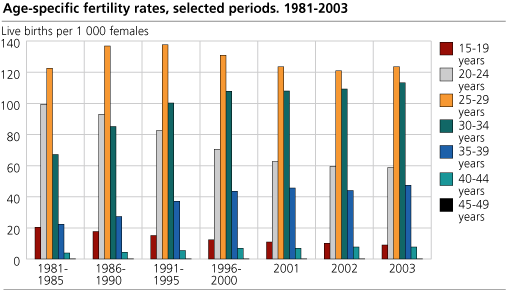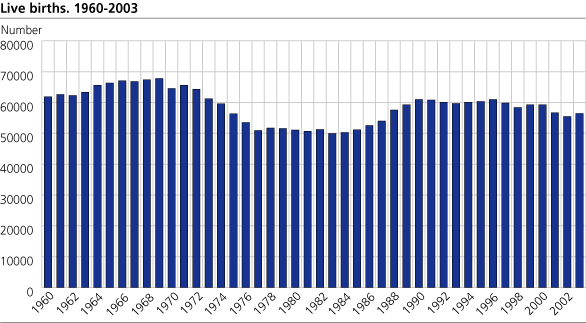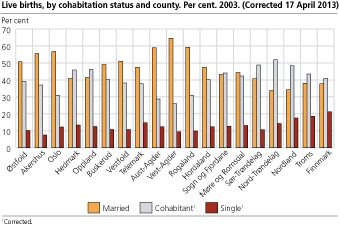Content
Published:
This is an archived release.
Stability in births and fertility
56 500 children were born in Norway during 2003, an increase of about 1000 compared with the year before. The corresponding total fertility rate was 1.80. The births-figures are at about the same level as the figures for 2001 when there were 56 700 live births.
Still decrease in fertility for women below 25 years of age
The fertility defined as live births per 1000 women, has decreased strongly during several decades for women below 25 year of age. This decrease also continued in 2003. For the age group 20-24 years the fertility was down to 58.9 live births per 1000 women.
For women aged 25-39 years there was a slight increase during the last year. Women in the last half of the twenties still had the highest fertility, 123.6 per 1000 women. Women in the age group 30-34 years came close with a fertility rate of 113.2. In relative figures, the increase in fertility was highest for women in the last half of the thirties, from 44.1 in 2002 to 47.5 in 2003.
For women in the forties it was, like earlier years, small changes in the fertility.
Highest fertility in Sogn og Fjordane
Sogn og Fjordane had the highest fertility in 2003, with a total fertility rate of 2.08. Sogn og Fjordane was followed by the counties Rogaland, Nord-Trøndelag and Møre og Romsdal with 1.99, 1.97 and 1.96 respectively. The fertility was lowest in Aust-Agder with 1.64, and Vestfold with 1.69.
Western Norway, Nord-Trøndelag, Nordland and Finnmark all had a total fertility rate above the average of the entire country at 1.80.
In most counties the fertility was almost at the same level as in 2002, or increased slightly. In three counties, Vest-Agder, Troms and Finnmark, the fertility decreased.
21 800 had cohabitating parents
About 21 800, or 38.6 per cent, of the children who were born during 2003 had cohabitating parents. The percentage of births with married parents was at about the same level as in 2002, 49.5 per cent.
There is a considerable difference among the counties concerning live births that had cohabitating parents. The counties Nord-Trøndelag and Sør-Trøndelag had the highest proportion, with 52 and 49 per cent respectively. Vest-Agder had the lowest proportion with 26 per cent.
The average age of those who became mothers for the first time was 27.9 years, 0.2 year higher than in 2002. The average age for all who became a father or a mother was 33.1 and 30.1 year. This is an increase of 0.3 year for fathers and 0.2 year for mothers compared with 2002.
I 2003 there was 1048 twin births and 18 triple births, which corresponds to 19.2 multiple births per 1000 births. For 2002 the corresponding figure was 19.4. The number on multiple births has increased steadily since the seventies, when the share of multiple births was about half of what it was in 2003.
Tables:
- Table 1 Live births and late foetal deaths. 1951-2003
- Table 2 Live births, by month. 1971-2003
- Table 3 Confinements of single and multiple births. 1956-2003
- Table 4 Confinements of single and multiple births, by sex. 1991-2003
- Table 5 Age-specific fertility rates and total fertility rate. 1961-2003 (Updated 27 April 2004)
- Table 6 Average age at birth. 1946-2003
- Table 7 Mean age of parents at all birth, by county. 2003
- Table 8 Total fertility rate, by county. 1968-2003
- Table 9 Live births, by parity. 1978-2003
- Table 10 Live births, by county and municipality. 2003
- Table 11 Live births, by cohabitation status of mother and county. 2001-2003
- Table 12 Live births, by parity, cohabitation status of mother and county. 2003
- Table 13 Mean age of mother and father and cohabitation status at birth of the child, by county. 2003
- Table 14 Number of children distributed, by age and cohort. Per cent (Updated 3 October 2005)
Contact
-
Statistics Norway's Information Centre
E-mail: informasjon@ssb.no
tel.: (+47) 21 09 46 42
-
Espen Andersen
E-mail: espen.andersen@ssb.no
tel.: (+47) 92 61 00 46
-
Ane Margrete Tømmerås
E-mail: ane.tommeras@ssb.no
tel.: (+47) 91 99 29 62
-
Oppdrag befolkningsstatistikk
E-mail: befolkning@ssb.no



